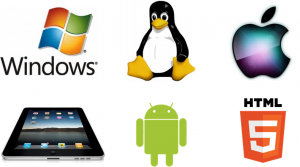“What’s the difference between HDX and ICA?”, “Is HDX 3D Pro different to HDX?”….. As a Product Manager these are questions I get asked a lot! We actually have a fantastic whitepaper, available here, covering what the HDX portfolio is. It has got a bit of marketing in there but fundamentally the technical descriptions of the technologies are very useful!
I’ve re-published the text of the current version of the white paper below but you can find the latest and most up-to-date version over on our product pages, here; alongside lots of other interesting HDX material.

Citrix HDX technologies for optimizing the virtualization experience
As application and desktop virtualization solutions go mainstream in the enterprise, IT organizations face the challenge of providing a virtual computing experience for employees that is the same or better than that of a local PC. A satisfying experience is essential, whether people are accessing their virtual apps and desktops from corporate-owned or BYO mobile devices, and whether they are connecting over challenging, low-bandwidth, high-latency WANs, highly variable 3G/4G mobile networks or reliable corporate networks (LANs).
Citrix HDX technologies address the full range of application performance and network challenges presented by virtualization. With HDX technologies, Citrix XenApp and Citrix XenDesktop deliver a brilliant user experience on a wide variety of devices and network connections, equaling or surpassing the local PC experience.
This white paper provides an overview of HDX™ capabilities and their benefits for users and IT administrators.
Introducing HDX technologies
HDX technologies offer a set of capabilities that deliver a “high-definition” experience to users of Windows applications and desktops, on any device and over any network. HDX technologies are built on top of the Citrix® ICA® remoting protocol, renowned for best-of-breed networking and representing more than 20 years of innovation. The ICA protocol is based on TCP/IP and RTP/UDP and is uniquely designed to traverse difficult network topologies such as mobile networks with high variability and low-bandwidth WANs with high latency characteristics.
Underpinning HDX are three technical principles intelligent redirection, adaptive compression and data de-duplication – which work in concert to optimize the user experience, decrease bandwidth consumption and increase the scalability of the hosting server.
- Intelligent redirection: entails examining screen activity, application commands, and endpoint device, network and server capabilities to instantly determine how and where to render an application or desktop activity. Redirection activity can occur at the local client or device.
- Client redirection offloads tasks from the server and places them on the client.
- With device and peripheral redirection, webcams, printers and scanners can be terminated locally to allow users to interact with these devices at native USB speeds.
- Adaptive compression: is a core intellectual property of the ICA protocol; it sets the codecs that are used during different network conditions, as well as determining intelligent utilization of CPU and/or GPU resources.#
- De-duplication of network traffic is accomplished through multicasting and caching techniques. HDX supports multicasting of multimedia streams, where delivery of a single transmission from the source to many users creates one-to-many communications. HDX caching de-duplicates commonly accessed data including bitmap graphics, files, print jobs and streamed media.
Deep compression of video and graphics using advanced H.264 video codec technology delivers higher frame rates, better image quality and best-in-class bandwidth efficiency. Originally developed as a XenDesktop HDX 3D Pro add-on to support designers and engineers using 3D professional graphics applications, H.264 extends beyond high-end 3D graphics and PC users. Today, mobile device users as well as Windows, Mac and Linux PC users who are accessing apps and desktops with XenApp® and XenDesktop® benefit from the latest video codec technology.
High-fidelity virtual audio performance with the lowest latency provided by the ICA protocol’s dedicated RTP/UDP audio channel ensures audio traffic always receives the highest network priority and includes packet tagging for QoS.
Client-side webcam compression for video communication and Adobe Flash and Windows Media multimedia playback redirection reduces bandwidth requirements by an order of magnitudeover networks with as much as 300milliseconds of latency, ensuring a native user experience even on mobile networks or at very remote locations.
HDX improves the unified communications (UC) experience by implementing an optimized codec designed for voice content between the client and the virtual desktop or session. Citrix has worked with major UC vendors including Microsoft (Lync), Cisco and Avaya to enable direct communication between endpoints to improve user experience and achieve greater server scalability. With these optimized unified communication solutions, audio and video move from endpoint to endpoint without traveling through the XenApp or XenDesktop host.
Multicast video support for Windows Media and Flash video permits a few, hundreds or even thousands of users to view video content that may be rendered and transmitted just once. This can produce enormous savings in bandwidth and datacenter resources for live video events, news channels, training programs and other content accessed by multiple users at once. This technology can reduce bandwidth requirements for a 50-person branch office by over 95 percent.
Optimizing 2D business and 3D professional graphics with HDX 3D Pro
HDX 3D Pro technologies optimize the performance of 2D business graphics and graphics-intensive 3D professional applications. HDX is far more than just a protocol
Deliver smooth voice, video and multimedia performance
Users expect app and desktop virtualization solutions to provide the same audio and multimedia reliability they receive from non-virtual desktop implementations. HDX technologies deliver bandwidth-efficient, crystal-clear voice, multimedia and video.
By leveraging both software and hardware-based rendering and compression capabilities, HDX 3D Pro delivers smoother graphical performance and network efficiency. The HDX 3D Pro deep compression codec delivers an exceptional, interactive user experience over WANs with as little as 1.5 Mbps and round-trip latency as high as 200ms.
2D business graphics
Citrix supports DirectX-based business graphics acceleration through the use of software rasterizer technology and CPU or GPU hardware. DirectX graphics command redirection to the client is supported by offloading Windows desktop composition from the server for scalability and enhanced user experience. In addition, HDX supports Microsoft RemoteFX graphics acceleration to enable the latest Windows Aero graphics.

3D professional graphics
Citrix is leading the way in the virtual delivery of 3D professional graphics applications and workstations. Its offerings include the first virtualization solution to support hardware- based GPU sharing of OpenGL and DirectX-based 3D professional graphics apps for achieving smooth graphics performance, and breakthrough deep compression technologies for maximizing traffic throughput over low-bandwidth networks. Lossless compression enables delivery of pixel-perfect images for applications such as medical imaging.
Example 3D professional graphics apps that benefit from HDX 3D Pro:
- Computer-aided design, manufacturing and engineering (CAD/CAM/CAE) applications
- Product life cycle and product data management apps (PLM/PDM)
- Geographical information system (GIS) software
- Picture archiving and communication systems (PACS) such as medical imaging
- Latest OpenGL, DirectX, NVidia CUDA and OpenCL versions GPU support
Provision many users to share a GPU to cost-effectively support users who view and edit 3D data by leveraging the NVIDIA GRID driver for true hardware-level GPU sharing (vGPU).To support designers and engineers who require a dedicated graphics card, HDX 3D Pro allows you to provision a GPU per user or VM with Citrix XenServer® GPU pass-through or VMware vSphere with vDGA.

Giving Windows apps a mobile-native look and feel with HDX Mobile
HDX Mobile improves the experience of CitrixReceiver™ users working in supported Windows applications and published server desktops on mobile devices. HDX includes a native interfacecontrol channel allowing Windows apps to bere-factored for a touch experience while leveraging device features such as multi- touch gestures, native menu controls, camera andGPS device functions. Many touch features are available natively in XenApp and XenDesktopand do not require any application source codec hanges to activate.Native touch features include:
- Automatic display of the keyboard when an editable field has the focus
- Larger picker control to replace Windows combo box control
- Multi-touch gestures such as pinch and zoom
- Inertia-sensed scrolling
- Touchpad or direct cursor navigation
Additional capabilities can be implemented using the HDX Windows Mobile Application SDK. It enables enterprise developers to update Windows applications just once for mobile devices using familiar Windows programming languages. The SDK includes more than 50 APIs.
Following are examples of programmable mobility enhancements:
- Control how buttons are used on the mobile device; use local user interface controls instead of Windows controls
- Autosense display size and re-factor apps to use available resolution and horizontal layout on a tablet or smaller mobile device screen
- Integrate device functions such as telephone, SMS, GPS and camera with Windows app workflows
Enhancing thin clients with HDX SoC embedded technology
Citrix provides an SDK to system-on-chip (SoC) vendors that enables compute-intensive HDX algorithms to execute outboard from the CPU, allowing inexpensive ARM processor-based devices to deliver a high-definition user experience.
Device manufacturers using these SoCs have now brought to market a broad portfolio of low-cost HDX Ready thin clients, zero clients and other products. Unlike competing solutions that burn the remoting protocol into silicon, which can result in device obsolescence within months, the Citrix approach supports ongoing innovation without hardware replacement. Click here for the latest information on HDX SoC thin clients available from HP, Dell/Wyse, NComputing and others.
Accelerating printing and scanning
Citrix supports both local USB and network printing. Local printing entails redirecting and terminating the printer locally to allow the user to interact with it at native USB speeds. Network-based printing is supported using Citrix Universal Print Server and Universal Print Driver technologies.
Citrix developed these print driver and print server technologies from the ground up for network printing. They provide many of the features needed for daily printing while taking into consideration the amount of bandwidth a print job requires. Using a single driver to manage hundreds or thousands of printers also simplifies management of print drivers on the Citrix host. With the Universal Print Server, the print engine is moved to a server so a Universal Print Driver is no longer required in the virtual desktop image. New firewall- friendly printing protocols provide greater bandwidth efficiency than native Windows protocols and extend printing to non- Windows devices.
Citrix CloudBridge™ branch caching analyses commonly used data such as file header and footer content and company logos, and caches the content locally on the print server for retrieval by users without resending the data for each print job.
Although scanners can be supported through basic USB direction, the Citrix implementation permits additional intelligence between the endpoint and the host. Local scanner termination allows the user to interact with the peripheral at native USB speeds. Once the scan is completed, ICA compresses the scanned image and sends it to the host server; thus, the only content that travels over the network is a compressed image.
Supporting the largest variety of USB devices
HDX provides seamless plug-and-play connectivity for a broad range of USB devices such as webcams, music players, audio recorders, specialty peripherals for 3D graphics designers, and cameras and GPS radios on mobile devices.
Ensuring the highest quality of service and reliability
HDX technologies ensure the highest quality of service and reliability through a combination of ICA traffic prioritization, branch office caching and ICA protocol optimizations. Virtual app and desktop traffic competes with everything else on a network. To meet stringent service level agreements (SLAs), network administrators need tools that help prioritize and optimize application and desktop traffic to deliver a great user experience every day. HDX traffic prioritization capabilities include:
- Prioritizing virtual app and desktop traffic based on usage type by segmenting the communication channel into five independent streams through standard QoS routing techniques. Virtual desktop traffic can be segmented into: 1. dedicated real-time, 2.interactive, 3. background, 4. bulk and 5. RTP/UDP voice channels.
- Application types can be identified, enabling network administrators to prioritize web and client-server applications alongside virtual apps and desktop traffic to maintain QoS while achieving the absolute best utilization of the available network bandwidth. A CloudBridge WAN optimization appliance is required for this functionality.
- WAN optimized branch caching is accomplished by CloudBridge with integrated HDX caching technology to provide groundbreaking multi-user optimization for virtual desktops and applications.
- Organizations can get more from their existing network infrastructure while providing a high-definition experience to branch office workers. HDX caching technology adaptively orchestrates with XenApp and XenDesktop to disable the native ICA compression used for optimizing single-user sessions.
- t then optimizes XenApp and XenDesktop delivery across multiple user sessions by locally caching and de-duplicating transmission of commonly accessed data, including bitmap graphics, files, print jobs and streamed media. Branch caching for hosted apps and desktops occurs transparently, requiring no additional configuration or tuning on the CloudBridge appliance or the XenApp/XenDesktop server.
- ICA protocol optimizations include TCP flow control, traffic compression and protocol acceleration.
- Adaptive TCP flow control accelerates the flow of all TCP-based traffic, including ICA, by sensing and responding to high network latency and packet loss. The result is significantly higher network throughput and performance than with standard TCP implementations.
- Adaptive compression uses a highly tuned engine to compress ICA traffic based on its characteristics, as well as infrastructure capabilities and network conditions.
- Adaptive protocol acceleration performs intelligent acceleration of ICA traffic while sensing and responding to network and traffic conditions. XenApp, XenDesktop and HDX technology
HDX technologies are the foundation of the Citrix apps and desktop delivery platform, which provides superior virtual app and desktop solution accessible from any device, over any network and gives end users an application and desktop experience that rivals that of a local PC—even when people are using multimedia, real-time collaboration, USB peripherals and 3D graphics apps over low-bandwidth, high-latency networks.
With XenApp and XenDesktop and HDX technologies, IT can successfully extend delivery of virtual apps and desktops beyond the corporate HQ to remote, mobile and branch office users.
Citrix (NASDAQ:CTXS) is a leader in mobile workspaces, providing virtualization, mobility management, networking and cloud services to enable new ways to work better. Citrix solutions power business mobility through secure, personal workspaces that provide people with instant access to apps, desktops, data and communications on any device, over any network and cloud. This year Citrix is celebrating 25 years of innovation, making IT simpler and people more productive. With annual revenue in 2013 of $2.9 billion, Citrix solutions are in use at more than 330,000 organizations and by over 100 million users globally. Learn more at www.citrix.com.
Copyright © 2014 Citrix Systems, Inc. All rights reserved. Citrix, HDX, ICA, XenDesktop, XenServer, XenApp, CloudBridge and Citrix Receiver are trademarks of Citrix Systems, Inc. and/or one of its subsidiaries, and may be registered in the U.S. and other countries. Other product and company names mentioned herein may be trademarks of their respective companies



